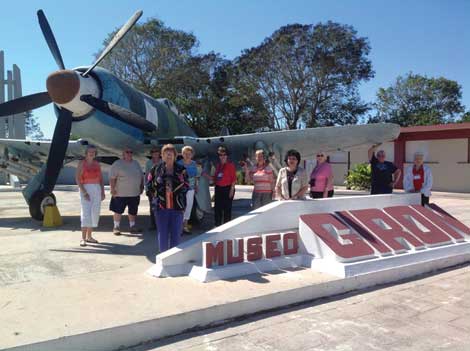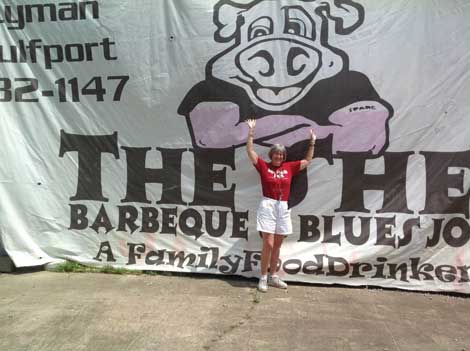Learning about Cuba behind the curtain
Our week in Cuba was definitely eye-opening, from our landing in Trinidad to our departure from Havana. We arrived home a better-educated and more compassionate group.Â
Our first destination was Trinidad, where we stayed at an all-inclusive beach resort, Brisas, built in 2000. It was much like going to an all-inclusive in Mexico – the welcoming entertainment and cocktail, exploration of the property to find our rooms, restaurants and lounges. The beach was beautiful and the sunsets magnificent. We had plenty of time to view the sunsets as we returned back late each afternoon, but only once was there time to view the beach. This was a “People to People†educational tour, the only way we could obtain the required visa. We were there to interact and learn and that we did.
Time was spent driving the countryside, lush and tropical with hills in the background; visiting markets with the usual jewelry, linens and wood-working; watching the people as they went about their business. The homes in this area were noticeably minimal but well-kept with no litter or graffiti to be seen. Most Cubans now “own†their own homes where multi-generational families reside. We were told that there is no unemployment but there are people who are “available to work.â€
A tour of a cigar factory was a highlight. We were not allowed to take photos but could definitely interact with the workers who were all smiles and excited to try to explain to us what they were doing. The art of pantomime worked both directions as we watched them pick out, pack and roll the leaves into the beautiful works of art those cigars can become. Working conditions were clean; the people looked healthy and happy; we felt more than welcomed.
A tour to the Botanical Gardens showed plants indigenous to the area but also transplanted from all over the world. Beautiful flowers and amazing trees were everywhere. Back in town, we were once again surrounded by the “old†American cars, taken into shops with meager supplies, toured through the theater and given a concert by a choir that is working hard to raise enough funds to tour the U.S. Dinner was at a “private†restaurant, as now the citizens can own their own businesses. It was sad to see that we were the only customers. The food was excellent, the service on the spot and entertainment was provided. Old, beautiful mansions have now been turned into some of these wonderful restaurants that are trying to survive.
It took a full day to travel by bus (Chinese-made) between Trinidad (population 70,000) and Havana (1.5 million). We learned tourism is the number 1 industry, with the U.S. being the number 2 country despite the embargo.
We visited the museum at the Bay of Pigs and learned, from the Cuban perspective, just what happened in 1961 and the area that was covered. We traveled on a steam train through the sugar cane fields and ate bananas fresh off the trees. Our lunch was in the jungle with a beautiful sinkhole-type pool, next to the restaurant and the ocean across the street.
Havana was all any of us expected. We resided at the National Hotel, built in 1930 and home to the rich and famous of the time. It has been beautifully restored and we were honored to be a part of it all. Looking at the pictures on the walls of those who have stayed since the ‘30s was absolutely amazing. This was our home but not our purpose, and we spent many hours driving around the city looking at buildings, comparing districts, seeing hospitals, walking streets and looking in small shops.
A visit to the Literacy Museum took us to 1961 when Fidel Casatro closed all the schools and sent the people out into the country. In the U.S., we thought this was horrible, but in Cuba it was a time of reform for the people. From as young as 8 years old, they went out of the cities and into the country to teach people to read and write. Over 230,000 people were involved in this, and now the illiteracy rate is less than 0.2 percent. Proof of the success was in the letters these people wrote to Fidel thanking him.
A stop at a “poly-clinic†gave us an inside view of healthcare. Every town has a clinic and doctors. This clinic had 24 family doctors and handles 27,000 inhabitants in the area. Healthcare is free. A rehab program was in place and doctors go out into the community.
To give us a little insight to the educational system, we were taken to an art school. The “art†at this school was “circus.†The students were ages 14 to 18. They maintained regular educational classes in the morning but then learned circus in the afternoon. We were made aware of their accomplishments with a performance.
Seniors are well taken care of. When they wish, they put their name on a list, much as we do, for housing in a senior community. The large home that we visited houses women on one side, men on the other, and had small apartments for couples. The singles were housed dormitory-style. Once again we noted the cleanliness and orderliness of the facilities. People were well, clean and happy. We learned that they received all their meals, healthcare and were even taken out on occasional day trips. Sounded a little like home but on a rather lower scale.
Not necessarily of a “people to people†nature, we were allowed to visit the Hemingway House where this famous author lived and worked. This was a magnificent tour into a home that was built in that era of luxury and decadence in Cuba before the revolution.
A last stop was made at the home of Fueste, an artist who is becoming a world-known master. He works a lot in mosaic and has rejuvenated his community by doing the walls and buildings.Â
On our last afternoon, we met with Camilo Garcia Lopez, a professor who tried to explain, from a Cuban perspective, what the revolution did and how Cubans and the U.S. look at each other. I would have to write considerably much more to get into that explanation, but it did open our eyes to a different viewpoint. There was much good discussion and hope that our countries could come to some agreement which would allow these people to grow and prosper and allow us the ability to freely travel here and have commercial business with them.
It was an amazing trip and one we will all remember. Asked why we wanted to go, we all said because we can.

